ACX702 - Applied Research Methods for Communication: Portfolio Report
VerifiedAdded on 2022/11/26
|16
|4854
|374
Report
AI Summary
This report, submitted by a student, details the application of applied research methods in communication, fulfilling the requirements of the ACX702 course. The report is divided into two parts: Part A focuses on three practical tasks, including an app walkthrough of Facebook, a content analysis of CNN news articles on gun violence, and an evaluation of research ethics in data collection from social media. Part B presents a reflexive essay, discussing the student's learning journey, strengths, weaknesses, and the applicability of the acquired knowledge to their field of study and future profession. The app walkthrough examines Facebook's vision, governance, and user experience. The content analysis assesses bias in news reporting on gun violence, while the ethics section evaluates ethical considerations in social media data collection. The reflexive essay provides a critical self-assessment of the student's understanding and application of research methods, highlighting the lessons learned and the potential for professional utilization of the acquired skills and knowledge. The report provides valuable insights into research methodologies and their practical application in communication studies.
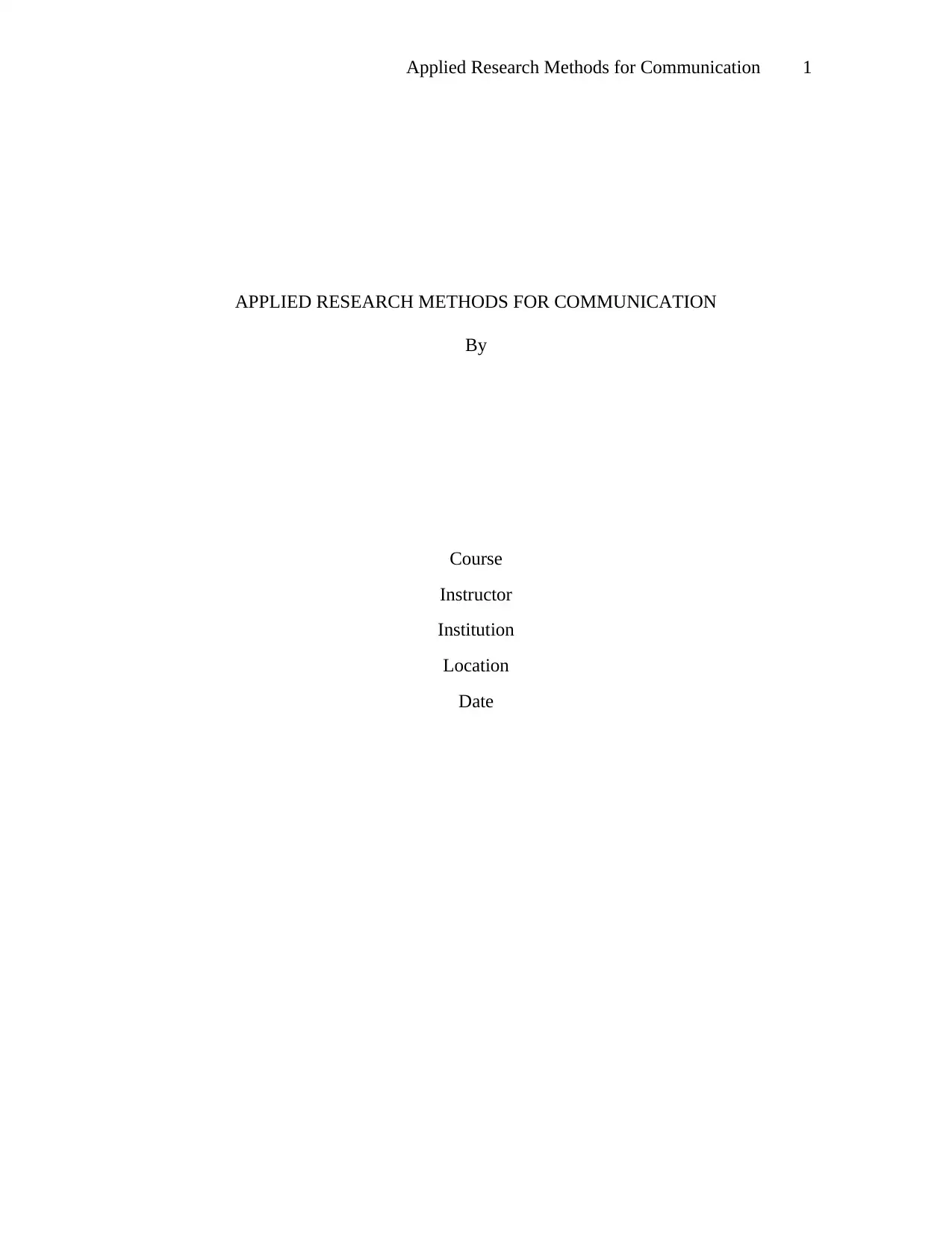
Applied Research Methods for Communication 1
APPLIED RESEARCH METHODS FOR COMMUNICATION
By
Course
Instructor
Institution
Location
Date
APPLIED RESEARCH METHODS FOR COMMUNICATION
By
Course
Instructor
Institution
Location
Date
Paraphrase This Document
Need a fresh take? Get an instant paraphrase of this document with our AI Paraphraser
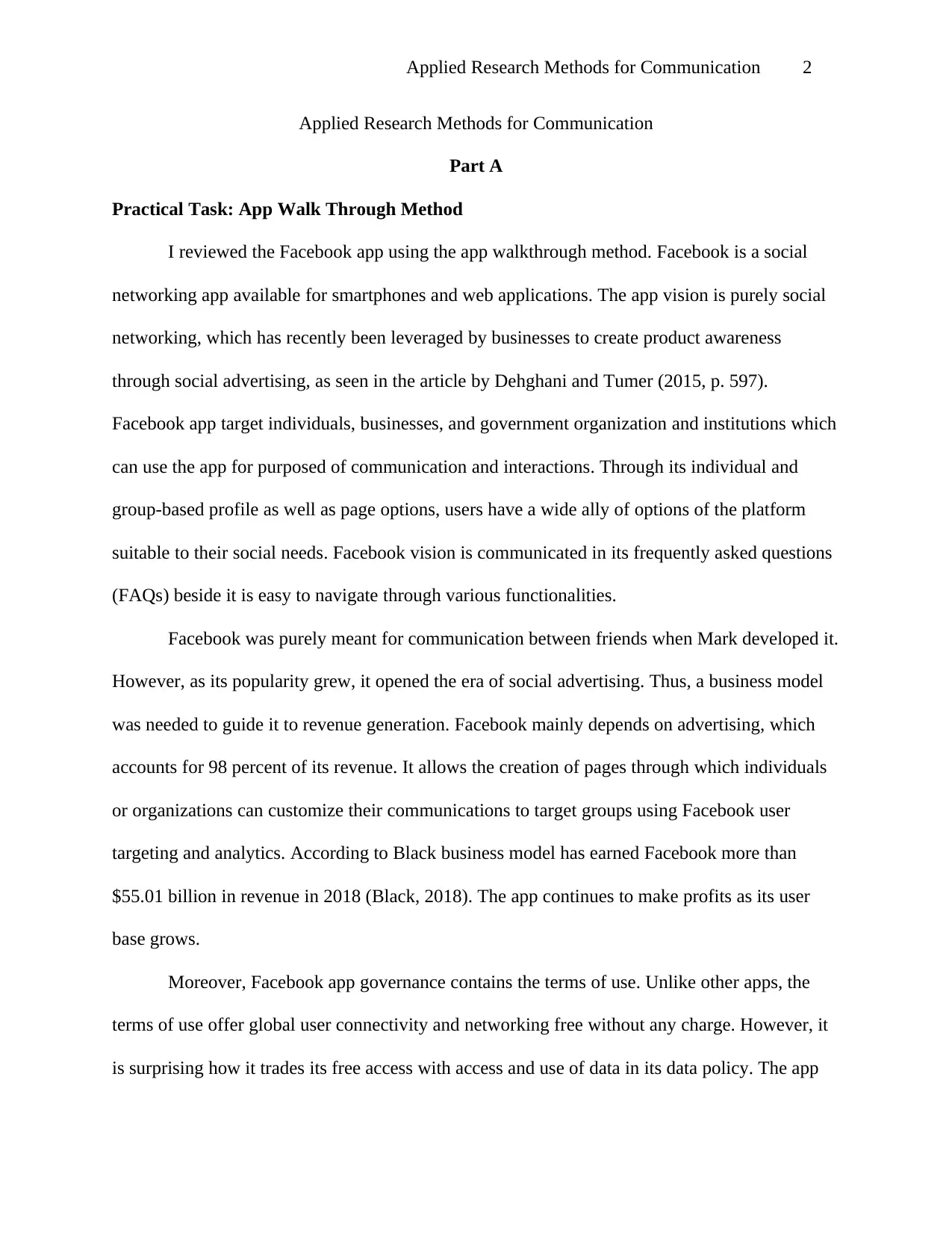
Applied Research Methods for Communication 2
Applied Research Methods for Communication
Part A
Practical Task: App Walk Through Method
I reviewed the Facebook app using the app walkthrough method. Facebook is a social
networking app available for smartphones and web applications. The app vision is purely social
networking, which has recently been leveraged by businesses to create product awareness
through social advertising, as seen in the article by Dehghani and Tumer (2015, p. 597).
Facebook app target individuals, businesses, and government organization and institutions which
can use the app for purposed of communication and interactions. Through its individual and
group-based profile as well as page options, users have a wide ally of options of the platform
suitable to their social needs. Facebook vision is communicated in its frequently asked questions
(FAQs) beside it is easy to navigate through various functionalities.
Facebook was purely meant for communication between friends when Mark developed it.
However, as its popularity grew, it opened the era of social advertising. Thus, a business model
was needed to guide it to revenue generation. Facebook mainly depends on advertising, which
accounts for 98 percent of its revenue. It allows the creation of pages through which individuals
or organizations can customize their communications to target groups using Facebook user
targeting and analytics. According to Black business model has earned Facebook more than
$55.01 billion in revenue in 2018 (Black, 2018). The app continues to make profits as its user
base grows.
Moreover, Facebook app governance contains the terms of use. Unlike other apps, the
terms of use offer global user connectivity and networking free without any charge. However, it
is surprising how it trades its free access with access and use of data in its data policy. The app
Applied Research Methods for Communication
Part A
Practical Task: App Walk Through Method
I reviewed the Facebook app using the app walkthrough method. Facebook is a social
networking app available for smartphones and web applications. The app vision is purely social
networking, which has recently been leveraged by businesses to create product awareness
through social advertising, as seen in the article by Dehghani and Tumer (2015, p. 597).
Facebook app target individuals, businesses, and government organization and institutions which
can use the app for purposed of communication and interactions. Through its individual and
group-based profile as well as page options, users have a wide ally of options of the platform
suitable to their social needs. Facebook vision is communicated in its frequently asked questions
(FAQs) beside it is easy to navigate through various functionalities.
Facebook was purely meant for communication between friends when Mark developed it.
However, as its popularity grew, it opened the era of social advertising. Thus, a business model
was needed to guide it to revenue generation. Facebook mainly depends on advertising, which
accounts for 98 percent of its revenue. It allows the creation of pages through which individuals
or organizations can customize their communications to target groups using Facebook user
targeting and analytics. According to Black business model has earned Facebook more than
$55.01 billion in revenue in 2018 (Black, 2018). The app continues to make profits as its user
base grows.
Moreover, Facebook app governance contains the terms of use. Unlike other apps, the
terms of use offer global user connectivity and networking free without any charge. However, it
is surprising how it trades its free access with access and use of data in its data policy. The app
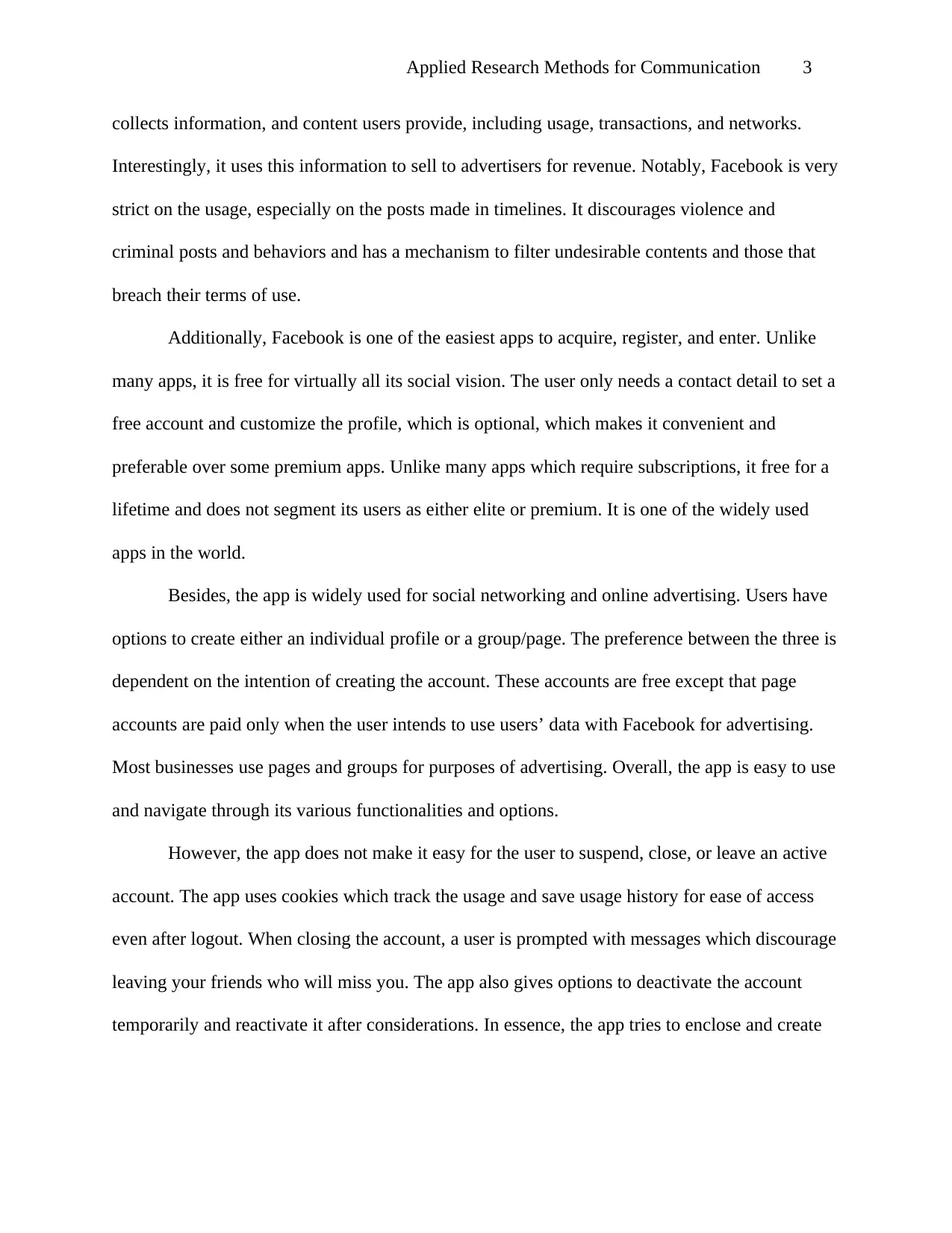
Applied Research Methods for Communication 3
collects information, and content users provide, including usage, transactions, and networks.
Interestingly, it uses this information to sell to advertisers for revenue. Notably, Facebook is very
strict on the usage, especially on the posts made in timelines. It discourages violence and
criminal posts and behaviors and has a mechanism to filter undesirable contents and those that
breach their terms of use.
Additionally, Facebook is one of the easiest apps to acquire, register, and enter. Unlike
many apps, it is free for virtually all its social vision. The user only needs a contact detail to set a
free account and customize the profile, which is optional, which makes it convenient and
preferable over some premium apps. Unlike many apps which require subscriptions, it free for a
lifetime and does not segment its users as either elite or premium. It is one of the widely used
apps in the world.
Besides, the app is widely used for social networking and online advertising. Users have
options to create either an individual profile or a group/page. The preference between the three is
dependent on the intention of creating the account. These accounts are free except that page
accounts are paid only when the user intends to use users’ data with Facebook for advertising.
Most businesses use pages and groups for purposes of advertising. Overall, the app is easy to use
and navigate through its various functionalities and options.
However, the app does not make it easy for the user to suspend, close, or leave an active
account. The app uses cookies which track the usage and save usage history for ease of access
even after logout. When closing the account, a user is prompted with messages which discourage
leaving your friends who will miss you. The app also gives options to deactivate the account
temporarily and reactivate it after considerations. In essence, the app tries to enclose and create
collects information, and content users provide, including usage, transactions, and networks.
Interestingly, it uses this information to sell to advertisers for revenue. Notably, Facebook is very
strict on the usage, especially on the posts made in timelines. It discourages violence and
criminal posts and behaviors and has a mechanism to filter undesirable contents and those that
breach their terms of use.
Additionally, Facebook is one of the easiest apps to acquire, register, and enter. Unlike
many apps, it is free for virtually all its social vision. The user only needs a contact detail to set a
free account and customize the profile, which is optional, which makes it convenient and
preferable over some premium apps. Unlike many apps which require subscriptions, it free for a
lifetime and does not segment its users as either elite or premium. It is one of the widely used
apps in the world.
Besides, the app is widely used for social networking and online advertising. Users have
options to create either an individual profile or a group/page. The preference between the three is
dependent on the intention of creating the account. These accounts are free except that page
accounts are paid only when the user intends to use users’ data with Facebook for advertising.
Most businesses use pages and groups for purposes of advertising. Overall, the app is easy to use
and navigate through its various functionalities and options.
However, the app does not make it easy for the user to suspend, close, or leave an active
account. The app uses cookies which track the usage and save usage history for ease of access
even after logout. When closing the account, a user is prompted with messages which discourage
leaving your friends who will miss you. The app also gives options to deactivate the account
temporarily and reactivate it after considerations. In essence, the app tries to enclose and create
⊘ This is a preview!⊘
Do you want full access?
Subscribe today to unlock all pages.

Trusted by 1+ million students worldwide
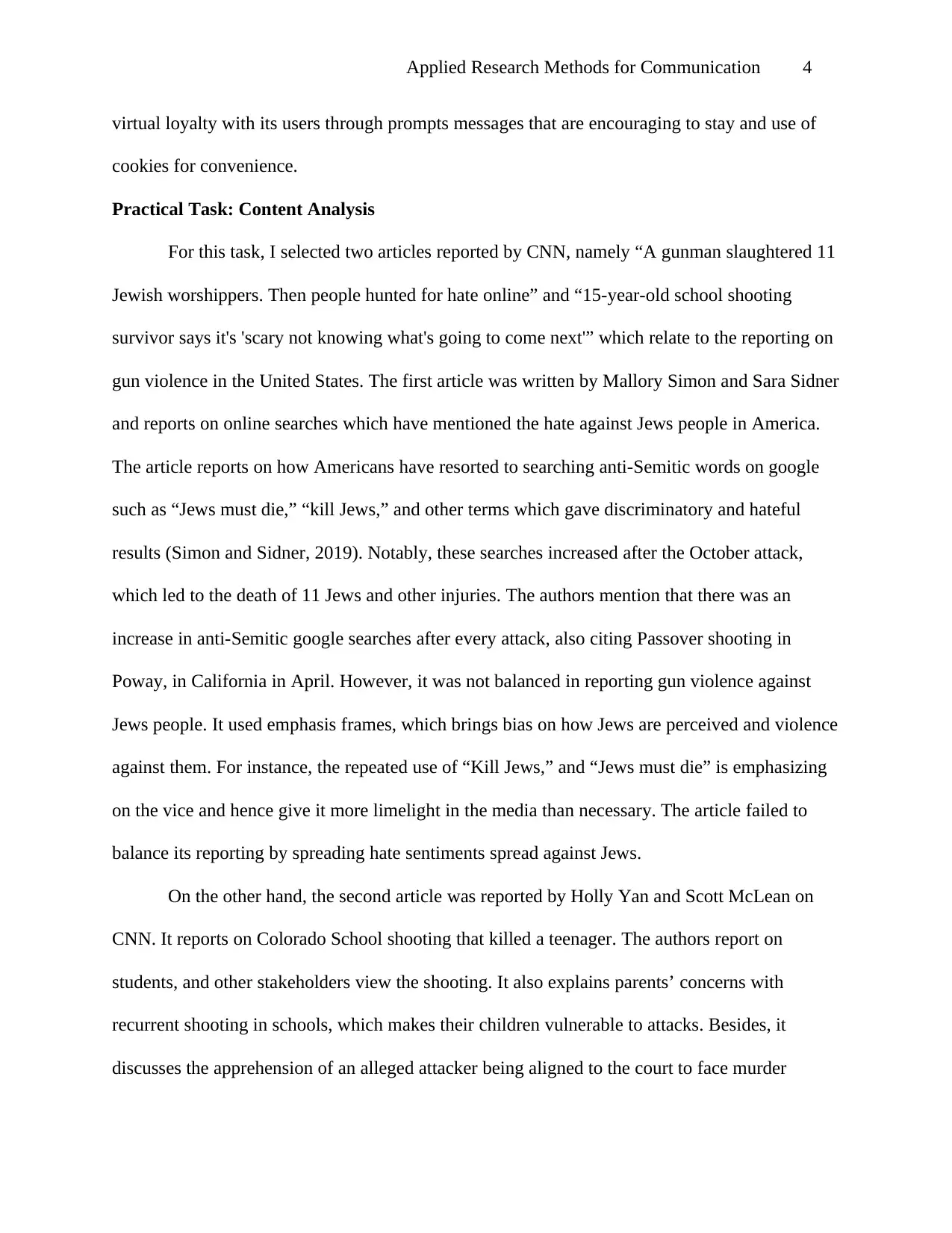
Applied Research Methods for Communication 4
virtual loyalty with its users through prompts messages that are encouraging to stay and use of
cookies for convenience.
Practical Task: Content Analysis
For this task, I selected two articles reported by CNN, namely “A gunman slaughtered 11
Jewish worshippers. Then people hunted for hate online” and “15-year-old school shooting
survivor says it's 'scary not knowing what's going to come next'” which relate to the reporting on
gun violence in the United States. The first article was written by Mallory Simon and Sara Sidner
and reports on online searches which have mentioned the hate against Jews people in America.
The article reports on how Americans have resorted to searching anti-Semitic words on google
such as “Jews must die,” “kill Jews,” and other terms which gave discriminatory and hateful
results (Simon and Sidner, 2019). Notably, these searches increased after the October attack,
which led to the death of 11 Jews and other injuries. The authors mention that there was an
increase in anti-Semitic google searches after every attack, also citing Passover shooting in
Poway, in California in April. However, it was not balanced in reporting gun violence against
Jews people. It used emphasis frames, which brings bias on how Jews are perceived and violence
against them. For instance, the repeated use of “Kill Jews,” and “Jews must die” is emphasizing
on the vice and hence give it more limelight in the media than necessary. The article failed to
balance its reporting by spreading hate sentiments spread against Jews.
On the other hand, the second article was reported by Holly Yan and Scott McLean on
CNN. It reports on Colorado School shooting that killed a teenager. The authors report on
students, and other stakeholders view the shooting. It also explains parents’ concerns with
recurrent shooting in schools, which makes their children vulnerable to attacks. Besides, it
discusses the apprehension of an alleged attacker being aligned to the court to face murder
virtual loyalty with its users through prompts messages that are encouraging to stay and use of
cookies for convenience.
Practical Task: Content Analysis
For this task, I selected two articles reported by CNN, namely “A gunman slaughtered 11
Jewish worshippers. Then people hunted for hate online” and “15-year-old school shooting
survivor says it's 'scary not knowing what's going to come next'” which relate to the reporting on
gun violence in the United States. The first article was written by Mallory Simon and Sara Sidner
and reports on online searches which have mentioned the hate against Jews people in America.
The article reports on how Americans have resorted to searching anti-Semitic words on google
such as “Jews must die,” “kill Jews,” and other terms which gave discriminatory and hateful
results (Simon and Sidner, 2019). Notably, these searches increased after the October attack,
which led to the death of 11 Jews and other injuries. The authors mention that there was an
increase in anti-Semitic google searches after every attack, also citing Passover shooting in
Poway, in California in April. However, it was not balanced in reporting gun violence against
Jews people. It used emphasis frames, which brings bias on how Jews are perceived and violence
against them. For instance, the repeated use of “Kill Jews,” and “Jews must die” is emphasizing
on the vice and hence give it more limelight in the media than necessary. The article failed to
balance its reporting by spreading hate sentiments spread against Jews.
On the other hand, the second article was reported by Holly Yan and Scott McLean on
CNN. It reports on Colorado School shooting that killed a teenager. The authors report on
students, and other stakeholders view the shooting. It also explains parents’ concerns with
recurrent shooting in schools, which makes their children vulnerable to attacks. Besides, it
discusses the apprehension of an alleged attacker being aligned to the court to face murder
Paraphrase This Document
Need a fresh take? Get an instant paraphrase of this document with our AI Paraphraser
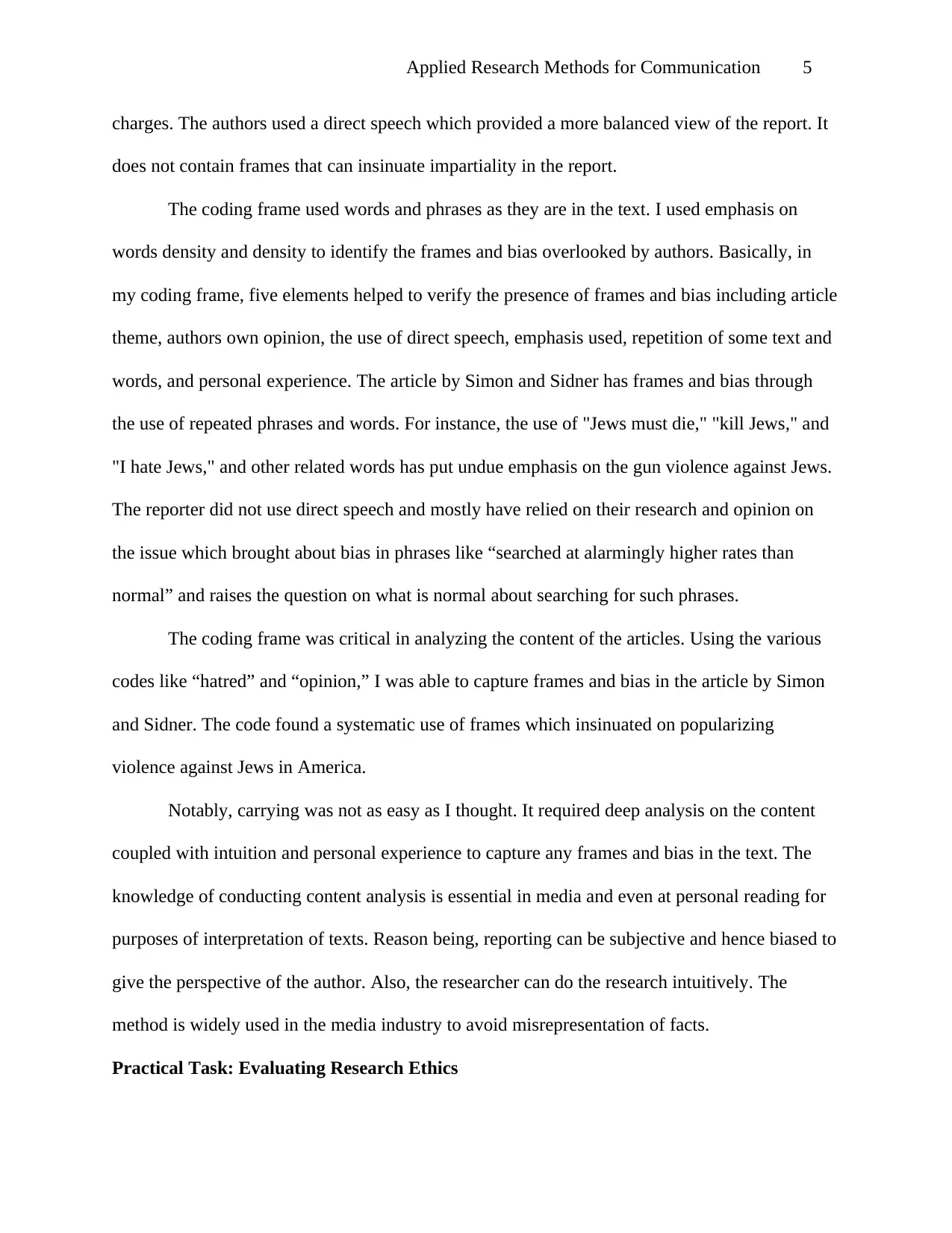
Applied Research Methods for Communication 5
charges. The authors used a direct speech which provided a more balanced view of the report. It
does not contain frames that can insinuate impartiality in the report.
The coding frame used words and phrases as they are in the text. I used emphasis on
words density and density to identify the frames and bias overlooked by authors. Basically, in
my coding frame, five elements helped to verify the presence of frames and bias including article
theme, authors own opinion, the use of direct speech, emphasis used, repetition of some text and
words, and personal experience. The article by Simon and Sidner has frames and bias through
the use of repeated phrases and words. For instance, the use of "Jews must die," "kill Jews," and
"I hate Jews," and other related words has put undue emphasis on the gun violence against Jews.
The reporter did not use direct speech and mostly have relied on their research and opinion on
the issue which brought about bias in phrases like “searched at alarmingly higher rates than
normal” and raises the question on what is normal about searching for such phrases.
The coding frame was critical in analyzing the content of the articles. Using the various
codes like “hatred” and “opinion,” I was able to capture frames and bias in the article by Simon
and Sidner. The code found a systematic use of frames which insinuated on popularizing
violence against Jews in America.
Notably, carrying was not as easy as I thought. It required deep analysis on the content
coupled with intuition and personal experience to capture any frames and bias in the text. The
knowledge of conducting content analysis is essential in media and even at personal reading for
purposes of interpretation of texts. Reason being, reporting can be subjective and hence biased to
give the perspective of the author. Also, the researcher can do the research intuitively. The
method is widely used in the media industry to avoid misrepresentation of facts.
Practical Task: Evaluating Research Ethics
charges. The authors used a direct speech which provided a more balanced view of the report. It
does not contain frames that can insinuate impartiality in the report.
The coding frame used words and phrases as they are in the text. I used emphasis on
words density and density to identify the frames and bias overlooked by authors. Basically, in
my coding frame, five elements helped to verify the presence of frames and bias including article
theme, authors own opinion, the use of direct speech, emphasis used, repetition of some text and
words, and personal experience. The article by Simon and Sidner has frames and bias through
the use of repeated phrases and words. For instance, the use of "Jews must die," "kill Jews," and
"I hate Jews," and other related words has put undue emphasis on the gun violence against Jews.
The reporter did not use direct speech and mostly have relied on their research and opinion on
the issue which brought about bias in phrases like “searched at alarmingly higher rates than
normal” and raises the question on what is normal about searching for such phrases.
The coding frame was critical in analyzing the content of the articles. Using the various
codes like “hatred” and “opinion,” I was able to capture frames and bias in the article by Simon
and Sidner. The code found a systematic use of frames which insinuated on popularizing
violence against Jews in America.
Notably, carrying was not as easy as I thought. It required deep analysis on the content
coupled with intuition and personal experience to capture any frames and bias in the text. The
knowledge of conducting content analysis is essential in media and even at personal reading for
purposes of interpretation of texts. Reason being, reporting can be subjective and hence biased to
give the perspective of the author. Also, the researcher can do the research intuitively. The
method is widely used in the media industry to avoid misrepresentation of facts.
Practical Task: Evaluating Research Ethics
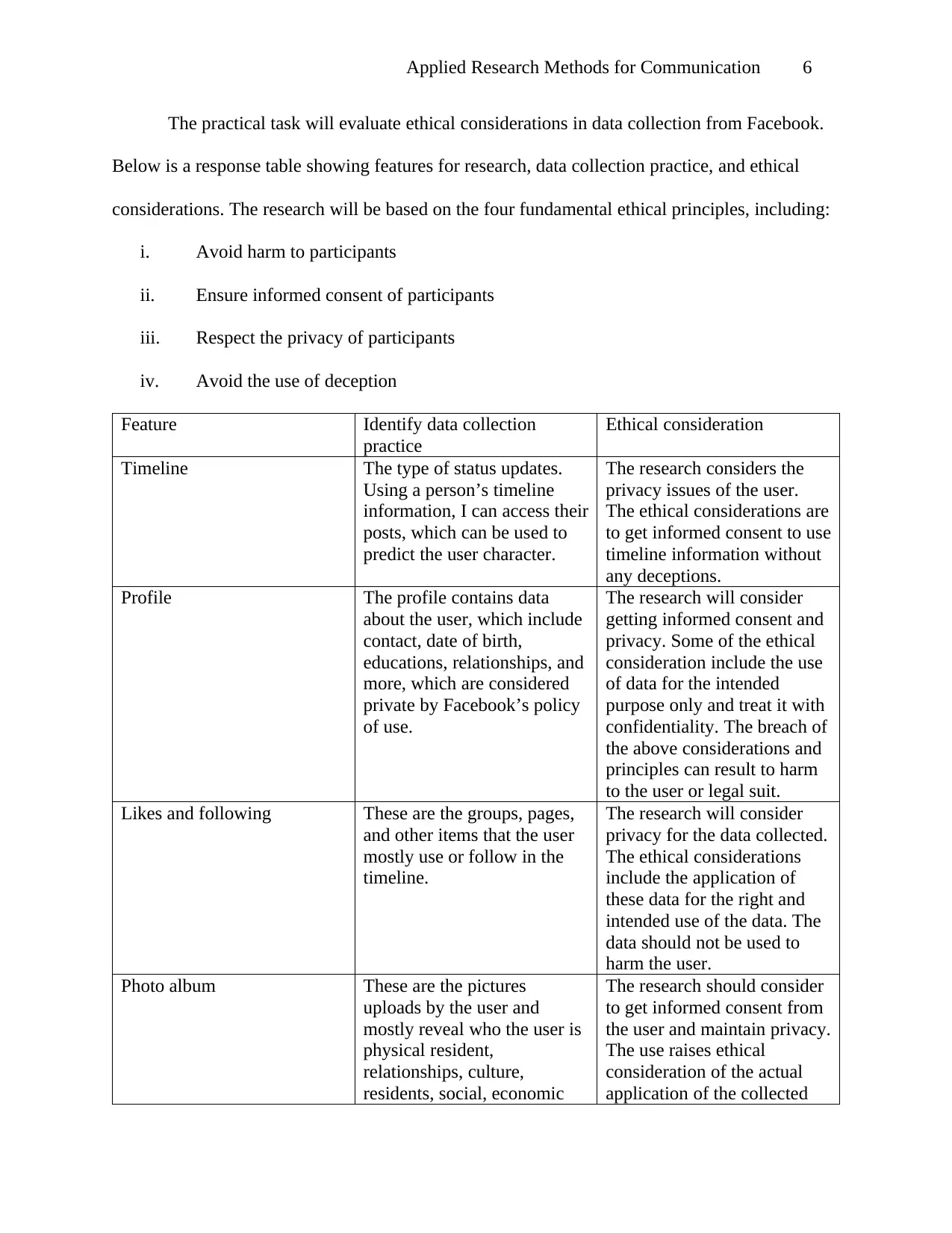
Applied Research Methods for Communication 6
The practical task will evaluate ethical considerations in data collection from Facebook.
Below is a response table showing features for research, data collection practice, and ethical
considerations. The research will be based on the four fundamental ethical principles, including:
i. Avoid harm to participants
ii. Ensure informed consent of participants
iii. Respect the privacy of participants
iv. Avoid the use of deception
Feature Identify data collection
practice
Ethical consideration
Timeline The type of status updates.
Using a person’s timeline
information, I can access their
posts, which can be used to
predict the user character.
The research considers the
privacy issues of the user.
The ethical considerations are
to get informed consent to use
timeline information without
any deceptions.
Profile The profile contains data
about the user, which include
contact, date of birth,
educations, relationships, and
more, which are considered
private by Facebook’s policy
of use.
The research will consider
getting informed consent and
privacy. Some of the ethical
consideration include the use
of data for the intended
purpose only and treat it with
confidentiality. The breach of
the above considerations and
principles can result to harm
to the user or legal suit.
Likes and following These are the groups, pages,
and other items that the user
mostly use or follow in the
timeline.
The research will consider
privacy for the data collected.
The ethical considerations
include the application of
these data for the right and
intended use of the data. The
data should not be used to
harm the user.
Photo album These are the pictures
uploads by the user and
mostly reveal who the user is
physical resident,
relationships, culture,
residents, social, economic
The research should consider
to get informed consent from
the user and maintain privacy.
The use raises ethical
consideration of the actual
application of the collected
The practical task will evaluate ethical considerations in data collection from Facebook.
Below is a response table showing features for research, data collection practice, and ethical
considerations. The research will be based on the four fundamental ethical principles, including:
i. Avoid harm to participants
ii. Ensure informed consent of participants
iii. Respect the privacy of participants
iv. Avoid the use of deception
Feature Identify data collection
practice
Ethical consideration
Timeline The type of status updates.
Using a person’s timeline
information, I can access their
posts, which can be used to
predict the user character.
The research considers the
privacy issues of the user.
The ethical considerations are
to get informed consent to use
timeline information without
any deceptions.
Profile The profile contains data
about the user, which include
contact, date of birth,
educations, relationships, and
more, which are considered
private by Facebook’s policy
of use.
The research will consider
getting informed consent and
privacy. Some of the ethical
consideration include the use
of data for the intended
purpose only and treat it with
confidentiality. The breach of
the above considerations and
principles can result to harm
to the user or legal suit.
Likes and following These are the groups, pages,
and other items that the user
mostly use or follow in the
timeline.
The research will consider
privacy for the data collected.
The ethical considerations
include the application of
these data for the right and
intended use of the data. The
data should not be used to
harm the user.
Photo album These are the pictures
uploads by the user and
mostly reveal who the user is
physical resident,
relationships, culture,
residents, social, economic
The research should consider
to get informed consent from
the user and maintain privacy.
The use raises ethical
consideration of the actual
application of the collected
⊘ This is a preview!⊘
Do you want full access?
Subscribe today to unlock all pages.

Trusted by 1+ million students worldwide
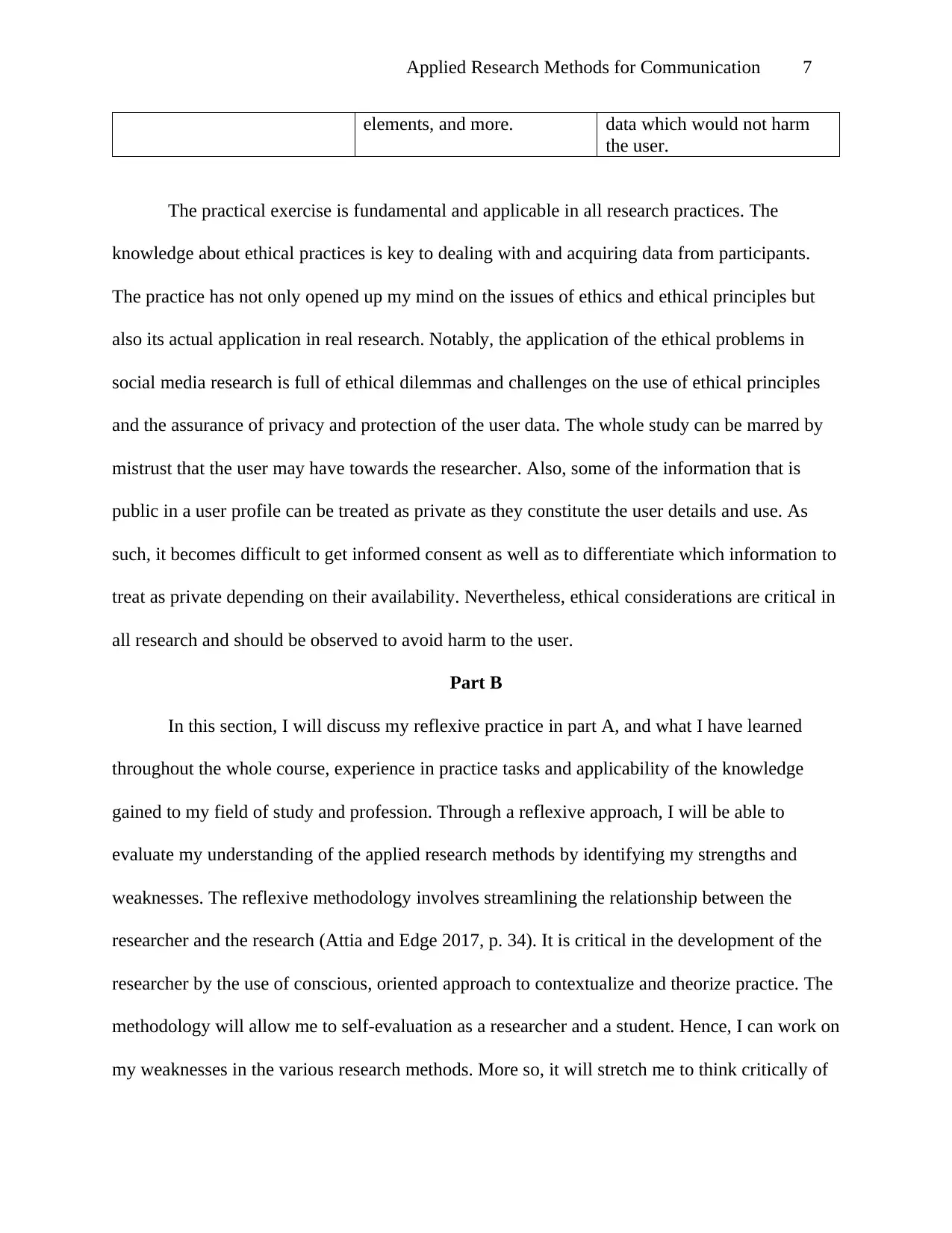
Applied Research Methods for Communication 7
elements, and more. data which would not harm
the user.
The practical exercise is fundamental and applicable in all research practices. The
knowledge about ethical practices is key to dealing with and acquiring data from participants.
The practice has not only opened up my mind on the issues of ethics and ethical principles but
also its actual application in real research. Notably, the application of the ethical problems in
social media research is full of ethical dilemmas and challenges on the use of ethical principles
and the assurance of privacy and protection of the user data. The whole study can be marred by
mistrust that the user may have towards the researcher. Also, some of the information that is
public in a user profile can be treated as private as they constitute the user details and use. As
such, it becomes difficult to get informed consent as well as to differentiate which information to
treat as private depending on their availability. Nevertheless, ethical considerations are critical in
all research and should be observed to avoid harm to the user.
Part B
In this section, I will discuss my reflexive practice in part A, and what I have learned
throughout the whole course, experience in practice tasks and applicability of the knowledge
gained to my field of study and profession. Through a reflexive approach, I will be able to
evaluate my understanding of the applied research methods by identifying my strengths and
weaknesses. The reflexive methodology involves streamlining the relationship between the
researcher and the research (Attia and Edge 2017, p. 34). It is critical in the development of the
researcher by the use of conscious, oriented approach to contextualize and theorize practice. The
methodology will allow me to self-evaluation as a researcher and a student. Hence, I can work on
my weaknesses in the various research methods. More so, it will stretch me to think critically of
elements, and more. data which would not harm
the user.
The practical exercise is fundamental and applicable in all research practices. The
knowledge about ethical practices is key to dealing with and acquiring data from participants.
The practice has not only opened up my mind on the issues of ethics and ethical principles but
also its actual application in real research. Notably, the application of the ethical problems in
social media research is full of ethical dilemmas and challenges on the use of ethical principles
and the assurance of privacy and protection of the user data. The whole study can be marred by
mistrust that the user may have towards the researcher. Also, some of the information that is
public in a user profile can be treated as private as they constitute the user details and use. As
such, it becomes difficult to get informed consent as well as to differentiate which information to
treat as private depending on their availability. Nevertheless, ethical considerations are critical in
all research and should be observed to avoid harm to the user.
Part B
In this section, I will discuss my reflexive practice in part A, and what I have learned
throughout the whole course, experience in practice tasks and applicability of the knowledge
gained to my field of study and profession. Through a reflexive approach, I will be able to
evaluate my understanding of the applied research methods by identifying my strengths and
weaknesses. The reflexive methodology involves streamlining the relationship between the
researcher and the research (Attia and Edge 2017, p. 34). It is critical in the development of the
researcher by the use of conscious, oriented approach to contextualize and theorize practice. The
methodology will allow me to self-evaluation as a researcher and a student. Hence, I can work on
my weaknesses in the various research methods. More so, it will stretch me to think critically of
Paraphrase This Document
Need a fresh take? Get an instant paraphrase of this document with our AI Paraphraser
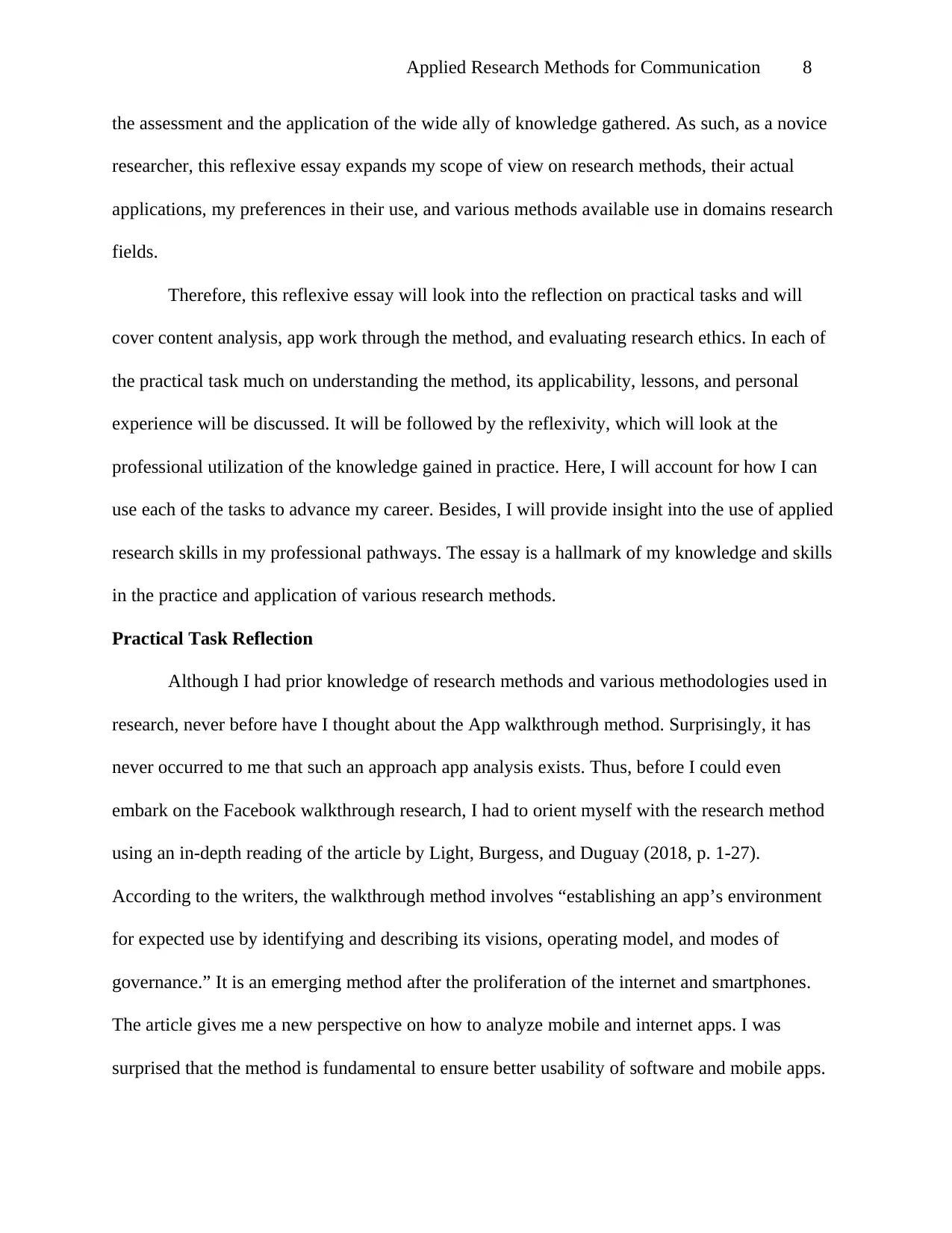
Applied Research Methods for Communication 8
the assessment and the application of the wide ally of knowledge gathered. As such, as a novice
researcher, this reflexive essay expands my scope of view on research methods, their actual
applications, my preferences in their use, and various methods available use in domains research
fields.
Therefore, this reflexive essay will look into the reflection on practical tasks and will
cover content analysis, app work through the method, and evaluating research ethics. In each of
the practical task much on understanding the method, its applicability, lessons, and personal
experience will be discussed. It will be followed by the reflexivity, which will look at the
professional utilization of the knowledge gained in practice. Here, I will account for how I can
use each of the tasks to advance my career. Besides, I will provide insight into the use of applied
research skills in my professional pathways. The essay is a hallmark of my knowledge and skills
in the practice and application of various research methods.
Practical Task Reflection
Although I had prior knowledge of research methods and various methodologies used in
research, never before have I thought about the App walkthrough method. Surprisingly, it has
never occurred to me that such an approach app analysis exists. Thus, before I could even
embark on the Facebook walkthrough research, I had to orient myself with the research method
using an in-depth reading of the article by Light, Burgess, and Duguay (2018, p. 1-27).
According to the writers, the walkthrough method involves “establishing an app’s environment
for expected use by identifying and describing its visions, operating model, and modes of
governance.” It is an emerging method after the proliferation of the internet and smartphones.
The article gives me a new perspective on how to analyze mobile and internet apps. I was
surprised that the method is fundamental to ensure better usability of software and mobile apps.
the assessment and the application of the wide ally of knowledge gathered. As such, as a novice
researcher, this reflexive essay expands my scope of view on research methods, their actual
applications, my preferences in their use, and various methods available use in domains research
fields.
Therefore, this reflexive essay will look into the reflection on practical tasks and will
cover content analysis, app work through the method, and evaluating research ethics. In each of
the practical task much on understanding the method, its applicability, lessons, and personal
experience will be discussed. It will be followed by the reflexivity, which will look at the
professional utilization of the knowledge gained in practice. Here, I will account for how I can
use each of the tasks to advance my career. Besides, I will provide insight into the use of applied
research skills in my professional pathways. The essay is a hallmark of my knowledge and skills
in the practice and application of various research methods.
Practical Task Reflection
Although I had prior knowledge of research methods and various methodologies used in
research, never before have I thought about the App walkthrough method. Surprisingly, it has
never occurred to me that such an approach app analysis exists. Thus, before I could even
embark on the Facebook walkthrough research, I had to orient myself with the research method
using an in-depth reading of the article by Light, Burgess, and Duguay (2018, p. 1-27).
According to the writers, the walkthrough method involves “establishing an app’s environment
for expected use by identifying and describing its visions, operating model, and modes of
governance.” It is an emerging method after the proliferation of the internet and smartphones.
The article gives me a new perspective on how to analyze mobile and internet apps. I was
surprised that the method is fundamental to ensure better usability of software and mobile apps.
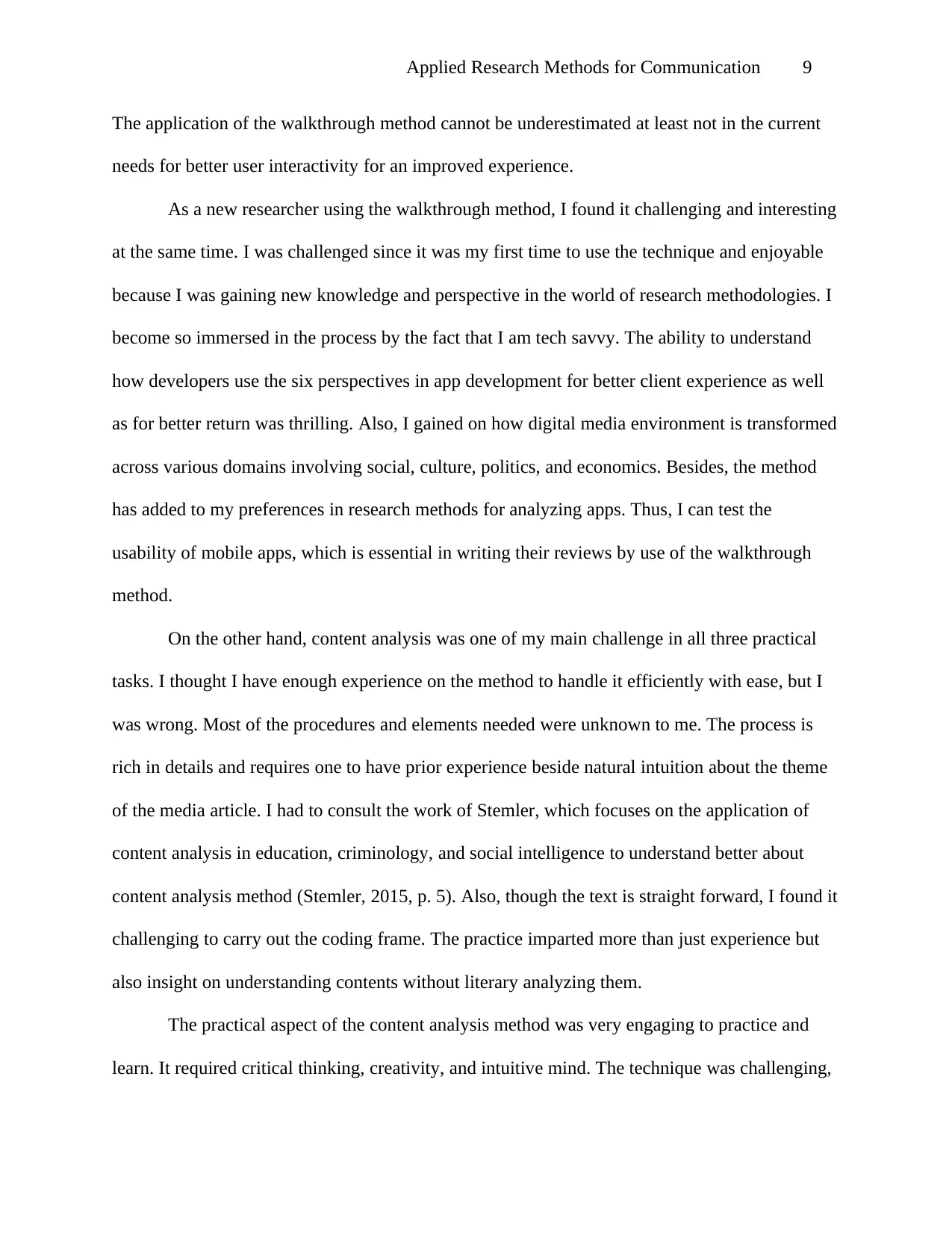
Applied Research Methods for Communication 9
The application of the walkthrough method cannot be underestimated at least not in the current
needs for better user interactivity for an improved experience.
As a new researcher using the walkthrough method, I found it challenging and interesting
at the same time. I was challenged since it was my first time to use the technique and enjoyable
because I was gaining new knowledge and perspective in the world of research methodologies. I
become so immersed in the process by the fact that I am tech savvy. The ability to understand
how developers use the six perspectives in app development for better client experience as well
as for better return was thrilling. Also, I gained on how digital media environment is transformed
across various domains involving social, culture, politics, and economics. Besides, the method
has added to my preferences in research methods for analyzing apps. Thus, I can test the
usability of mobile apps, which is essential in writing their reviews by use of the walkthrough
method.
On the other hand, content analysis was one of my main challenge in all three practical
tasks. I thought I have enough experience on the method to handle it efficiently with ease, but I
was wrong. Most of the procedures and elements needed were unknown to me. The process is
rich in details and requires one to have prior experience beside natural intuition about the theme
of the media article. I had to consult the work of Stemler, which focuses on the application of
content analysis in education, criminology, and social intelligence to understand better about
content analysis method (Stemler, 2015, p. 5). Also, though the text is straight forward, I found it
challenging to carry out the coding frame. The practice imparted more than just experience but
also insight on understanding contents without literary analyzing them.
The practical aspect of the content analysis method was very engaging to practice and
learn. It required critical thinking, creativity, and intuitive mind. The technique was challenging,
The application of the walkthrough method cannot be underestimated at least not in the current
needs for better user interactivity for an improved experience.
As a new researcher using the walkthrough method, I found it challenging and interesting
at the same time. I was challenged since it was my first time to use the technique and enjoyable
because I was gaining new knowledge and perspective in the world of research methodologies. I
become so immersed in the process by the fact that I am tech savvy. The ability to understand
how developers use the six perspectives in app development for better client experience as well
as for better return was thrilling. Also, I gained on how digital media environment is transformed
across various domains involving social, culture, politics, and economics. Besides, the method
has added to my preferences in research methods for analyzing apps. Thus, I can test the
usability of mobile apps, which is essential in writing their reviews by use of the walkthrough
method.
On the other hand, content analysis was one of my main challenge in all three practical
tasks. I thought I have enough experience on the method to handle it efficiently with ease, but I
was wrong. Most of the procedures and elements needed were unknown to me. The process is
rich in details and requires one to have prior experience beside natural intuition about the theme
of the media article. I had to consult the work of Stemler, which focuses on the application of
content analysis in education, criminology, and social intelligence to understand better about
content analysis method (Stemler, 2015, p. 5). Also, though the text is straight forward, I found it
challenging to carry out the coding frame. The practice imparted more than just experience but
also insight on understanding contents without literary analyzing them.
The practical aspect of the content analysis method was very engaging to practice and
learn. It required critical thinking, creativity, and intuitive mind. The technique was challenging,
⊘ This is a preview!⊘
Do you want full access?
Subscribe today to unlock all pages.

Trusted by 1+ million students worldwide
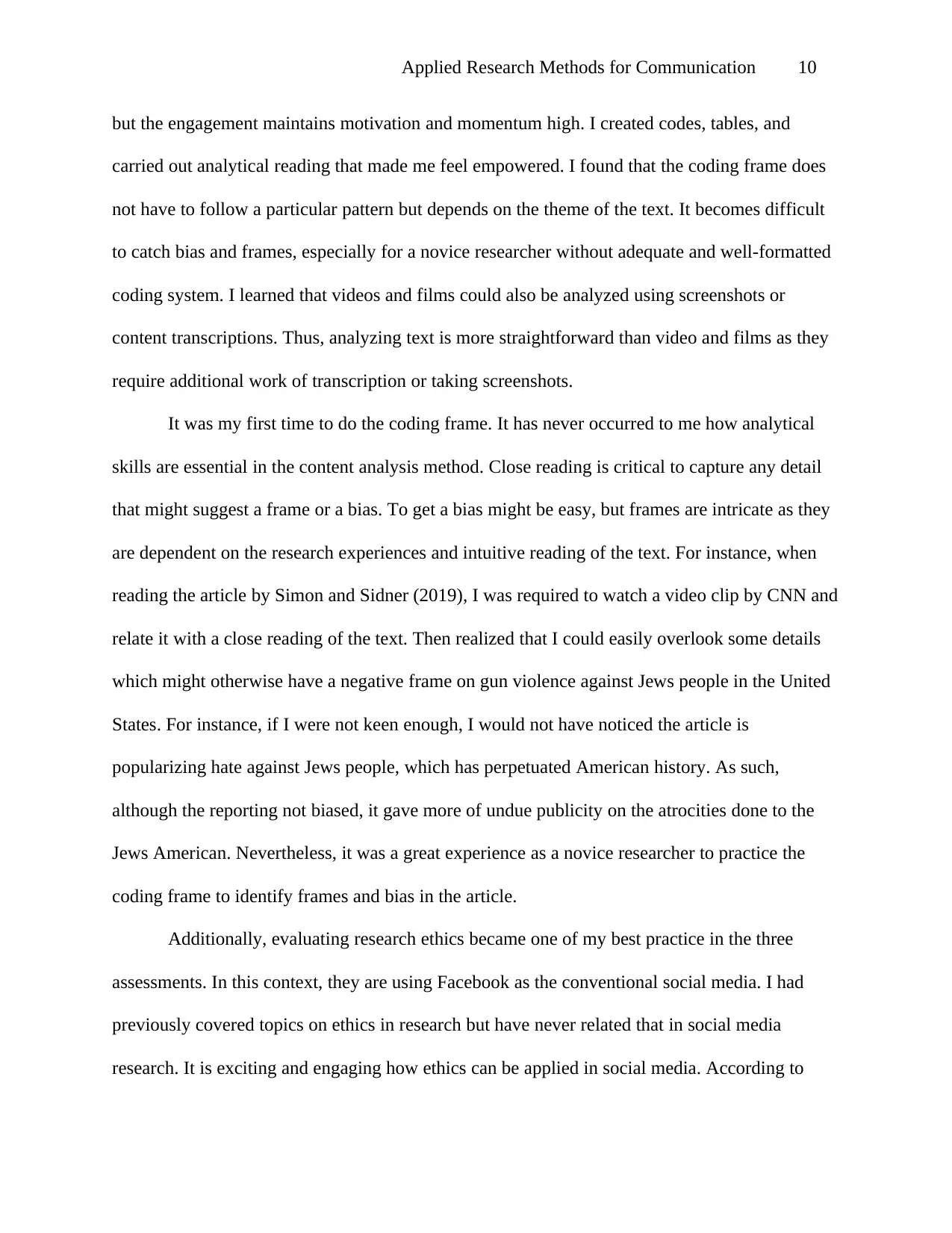
Applied Research Methods for Communication 10
but the engagement maintains motivation and momentum high. I created codes, tables, and
carried out analytical reading that made me feel empowered. I found that the coding frame does
not have to follow a particular pattern but depends on the theme of the text. It becomes difficult
to catch bias and frames, especially for a novice researcher without adequate and well-formatted
coding system. I learned that videos and films could also be analyzed using screenshots or
content transcriptions. Thus, analyzing text is more straightforward than video and films as they
require additional work of transcription or taking screenshots.
It was my first time to do the coding frame. It has never occurred to me how analytical
skills are essential in the content analysis method. Close reading is critical to capture any detail
that might suggest a frame or a bias. To get a bias might be easy, but frames are intricate as they
are dependent on the research experiences and intuitive reading of the text. For instance, when
reading the article by Simon and Sidner (2019), I was required to watch a video clip by CNN and
relate it with a close reading of the text. Then realized that I could easily overlook some details
which might otherwise have a negative frame on gun violence against Jews people in the United
States. For instance, if I were not keen enough, I would not have noticed the article is
popularizing hate against Jews people, which has perpetuated American history. As such,
although the reporting not biased, it gave more of undue publicity on the atrocities done to the
Jews American. Nevertheless, it was a great experience as a novice researcher to practice the
coding frame to identify frames and bias in the article.
Additionally, evaluating research ethics became one of my best practice in the three
assessments. In this context, they are using Facebook as the conventional social media. I had
previously covered topics on ethics in research but have never related that in social media
research. It is exciting and engaging how ethics can be applied in social media. According to
but the engagement maintains motivation and momentum high. I created codes, tables, and
carried out analytical reading that made me feel empowered. I found that the coding frame does
not have to follow a particular pattern but depends on the theme of the text. It becomes difficult
to catch bias and frames, especially for a novice researcher without adequate and well-formatted
coding system. I learned that videos and films could also be analyzed using screenshots or
content transcriptions. Thus, analyzing text is more straightforward than video and films as they
require additional work of transcription or taking screenshots.
It was my first time to do the coding frame. It has never occurred to me how analytical
skills are essential in the content analysis method. Close reading is critical to capture any detail
that might suggest a frame or a bias. To get a bias might be easy, but frames are intricate as they
are dependent on the research experiences and intuitive reading of the text. For instance, when
reading the article by Simon and Sidner (2019), I was required to watch a video clip by CNN and
relate it with a close reading of the text. Then realized that I could easily overlook some details
which might otherwise have a negative frame on gun violence against Jews people in the United
States. For instance, if I were not keen enough, I would not have noticed the article is
popularizing hate against Jews people, which has perpetuated American history. As such,
although the reporting not biased, it gave more of undue publicity on the atrocities done to the
Jews American. Nevertheless, it was a great experience as a novice researcher to practice the
coding frame to identify frames and bias in the article.
Additionally, evaluating research ethics became one of my best practice in the three
assessments. In this context, they are using Facebook as the conventional social media. I had
previously covered topics on ethics in research but have never related that in social media
research. It is exciting and engaging how ethics can be applied in social media. According to
Paraphrase This Document
Need a fresh take? Get an instant paraphrase of this document with our AI Paraphraser
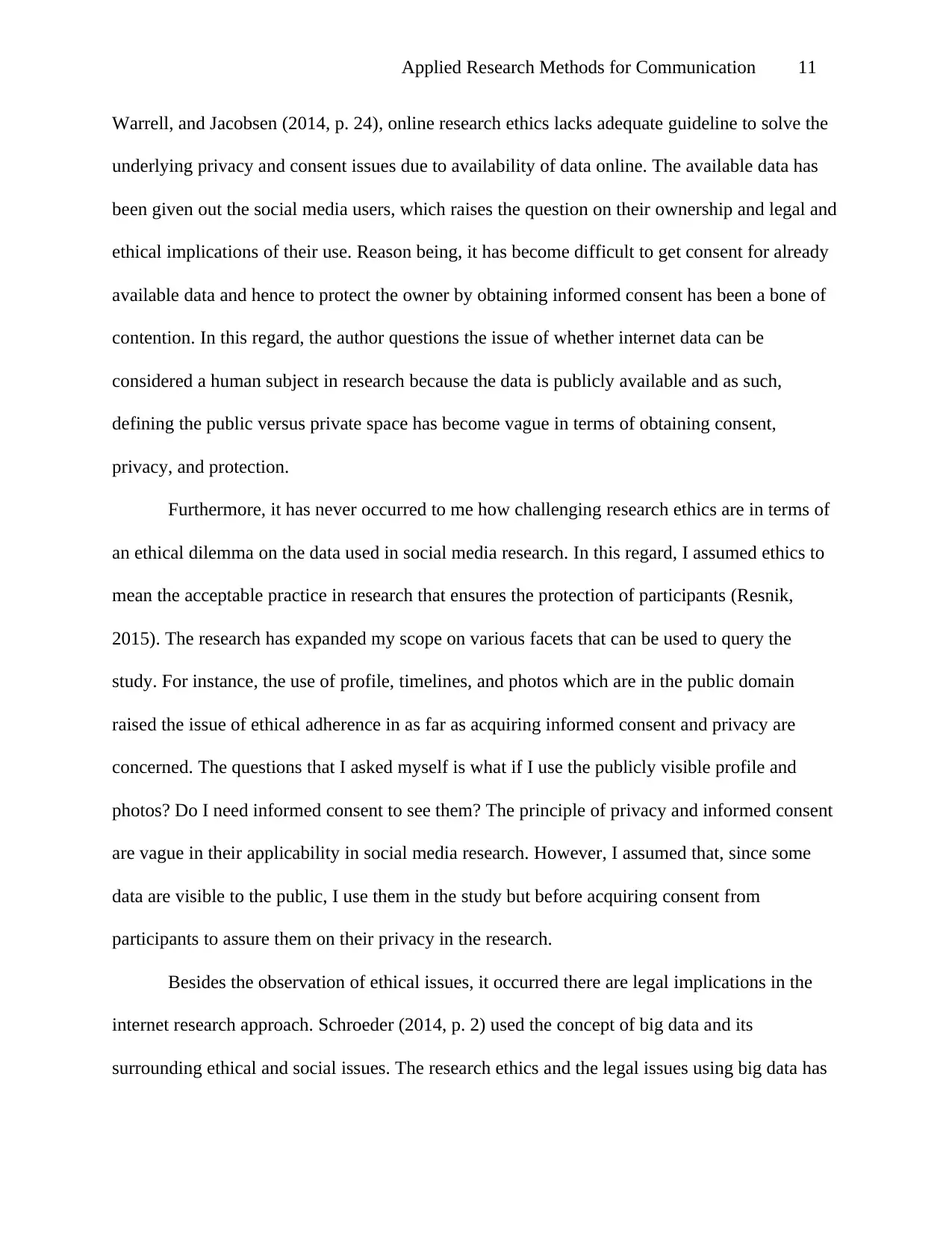
Applied Research Methods for Communication 11
Warrell, and Jacobsen (2014, p. 24), online research ethics lacks adequate guideline to solve the
underlying privacy and consent issues due to availability of data online. The available data has
been given out the social media users, which raises the question on their ownership and legal and
ethical implications of their use. Reason being, it has become difficult to get consent for already
available data and hence to protect the owner by obtaining informed consent has been a bone of
contention. In this regard, the author questions the issue of whether internet data can be
considered a human subject in research because the data is publicly available and as such,
defining the public versus private space has become vague in terms of obtaining consent,
privacy, and protection.
Furthermore, it has never occurred to me how challenging research ethics are in terms of
an ethical dilemma on the data used in social media research. In this regard, I assumed ethics to
mean the acceptable practice in research that ensures the protection of participants (Resnik,
2015). The research has expanded my scope on various facets that can be used to query the
study. For instance, the use of profile, timelines, and photos which are in the public domain
raised the issue of ethical adherence in as far as acquiring informed consent and privacy are
concerned. The questions that I asked myself is what if I use the publicly visible profile and
photos? Do I need informed consent to see them? The principle of privacy and informed consent
are vague in their applicability in social media research. However, I assumed that, since some
data are visible to the public, I use them in the study but before acquiring consent from
participants to assure them on their privacy in the research.
Besides the observation of ethical issues, it occurred there are legal implications in the
internet research approach. Schroeder (2014, p. 2) used the concept of big data and its
surrounding ethical and social issues. The research ethics and the legal issues using big data has
Warrell, and Jacobsen (2014, p. 24), online research ethics lacks adequate guideline to solve the
underlying privacy and consent issues due to availability of data online. The available data has
been given out the social media users, which raises the question on their ownership and legal and
ethical implications of their use. Reason being, it has become difficult to get consent for already
available data and hence to protect the owner by obtaining informed consent has been a bone of
contention. In this regard, the author questions the issue of whether internet data can be
considered a human subject in research because the data is publicly available and as such,
defining the public versus private space has become vague in terms of obtaining consent,
privacy, and protection.
Furthermore, it has never occurred to me how challenging research ethics are in terms of
an ethical dilemma on the data used in social media research. In this regard, I assumed ethics to
mean the acceptable practice in research that ensures the protection of participants (Resnik,
2015). The research has expanded my scope on various facets that can be used to query the
study. For instance, the use of profile, timelines, and photos which are in the public domain
raised the issue of ethical adherence in as far as acquiring informed consent and privacy are
concerned. The questions that I asked myself is what if I use the publicly visible profile and
photos? Do I need informed consent to see them? The principle of privacy and informed consent
are vague in their applicability in social media research. However, I assumed that, since some
data are visible to the public, I use them in the study but before acquiring consent from
participants to assure them on their privacy in the research.
Besides the observation of ethical issues, it occurred there are legal implications in the
internet research approach. Schroeder (2014, p. 2) used the concept of big data and its
surrounding ethical and social issues. The research ethics and the legal issues using big data has
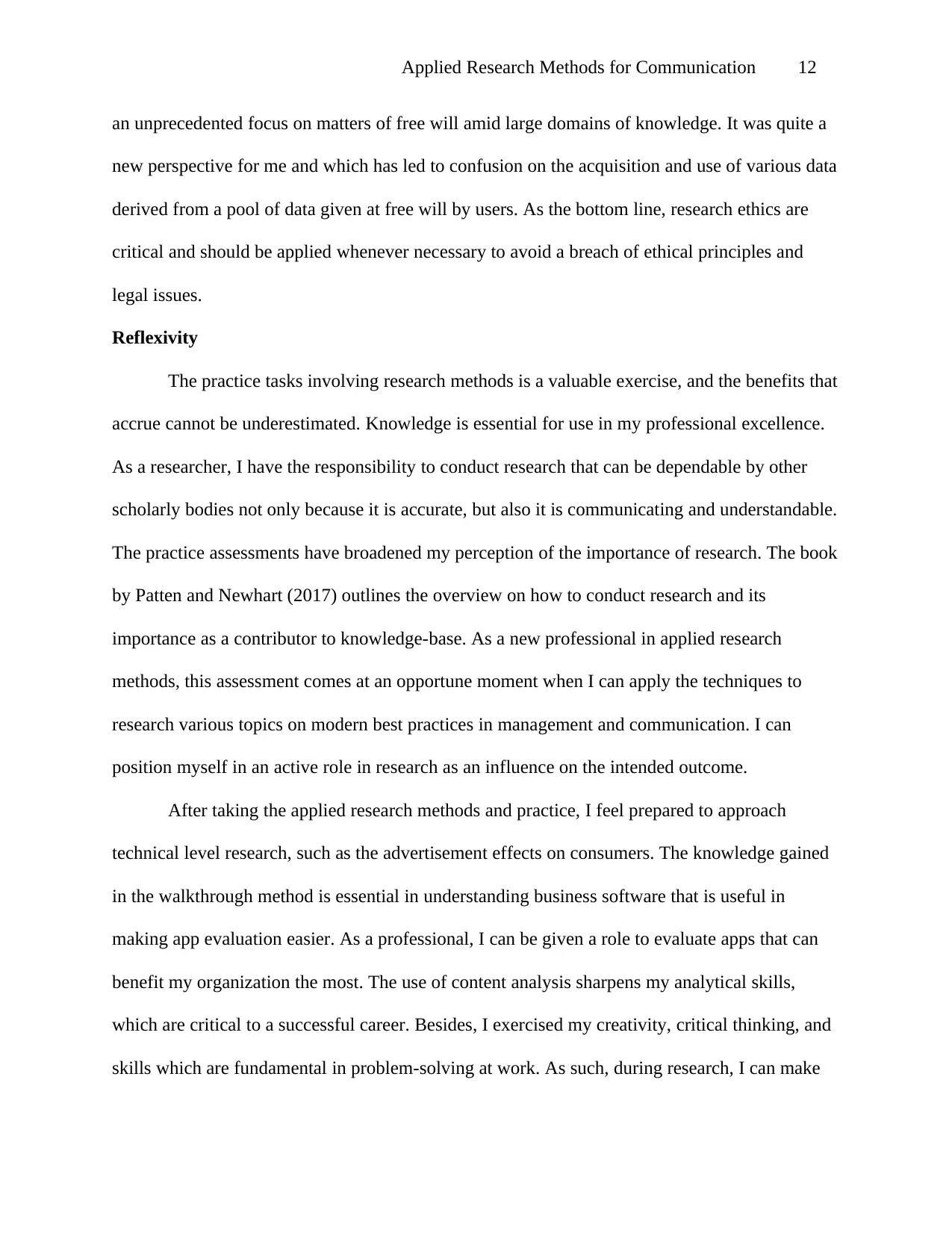
Applied Research Methods for Communication 12
an unprecedented focus on matters of free will amid large domains of knowledge. It was quite a
new perspective for me and which has led to confusion on the acquisition and use of various data
derived from a pool of data given at free will by users. As the bottom line, research ethics are
critical and should be applied whenever necessary to avoid a breach of ethical principles and
legal issues.
Reflexivity
The practice tasks involving research methods is a valuable exercise, and the benefits that
accrue cannot be underestimated. Knowledge is essential for use in my professional excellence.
As a researcher, I have the responsibility to conduct research that can be dependable by other
scholarly bodies not only because it is accurate, but also it is communicating and understandable.
The practice assessments have broadened my perception of the importance of research. The book
by Patten and Newhart (2017) outlines the overview on how to conduct research and its
importance as a contributor to knowledge-base. As a new professional in applied research
methods, this assessment comes at an opportune moment when I can apply the techniques to
research various topics on modern best practices in management and communication. I can
position myself in an active role in research as an influence on the intended outcome.
After taking the applied research methods and practice, I feel prepared to approach
technical level research, such as the advertisement effects on consumers. The knowledge gained
in the walkthrough method is essential in understanding business software that is useful in
making app evaluation easier. As a professional, I can be given a role to evaluate apps that can
benefit my organization the most. The use of content analysis sharpens my analytical skills,
which are critical to a successful career. Besides, I exercised my creativity, critical thinking, and
skills which are fundamental in problem-solving at work. As such, during research, I can make
an unprecedented focus on matters of free will amid large domains of knowledge. It was quite a
new perspective for me and which has led to confusion on the acquisition and use of various data
derived from a pool of data given at free will by users. As the bottom line, research ethics are
critical and should be applied whenever necessary to avoid a breach of ethical principles and
legal issues.
Reflexivity
The practice tasks involving research methods is a valuable exercise, and the benefits that
accrue cannot be underestimated. Knowledge is essential for use in my professional excellence.
As a researcher, I have the responsibility to conduct research that can be dependable by other
scholarly bodies not only because it is accurate, but also it is communicating and understandable.
The practice assessments have broadened my perception of the importance of research. The book
by Patten and Newhart (2017) outlines the overview on how to conduct research and its
importance as a contributor to knowledge-base. As a new professional in applied research
methods, this assessment comes at an opportune moment when I can apply the techniques to
research various topics on modern best practices in management and communication. I can
position myself in an active role in research as an influence on the intended outcome.
After taking the applied research methods and practice, I feel prepared to approach
technical level research, such as the advertisement effects on consumers. The knowledge gained
in the walkthrough method is essential in understanding business software that is useful in
making app evaluation easier. As a professional, I can be given a role to evaluate apps that can
benefit my organization the most. The use of content analysis sharpens my analytical skills,
which are critical to a successful career. Besides, I exercised my creativity, critical thinking, and
skills which are fundamental in problem-solving at work. As such, during research, I can make
⊘ This is a preview!⊘
Do you want full access?
Subscribe today to unlock all pages.

Trusted by 1+ million students worldwide
1 out of 16
Related Documents
Your All-in-One AI-Powered Toolkit for Academic Success.
+13062052269
info@desklib.com
Available 24*7 on WhatsApp / Email
![[object Object]](/_next/static/media/star-bottom.7253800d.svg)
Unlock your academic potential
Copyright © 2020–2025 A2Z Services. All Rights Reserved. Developed and managed by ZUCOL.





